Structural Analysis of Carbon Fiber 3D-Printed Ribs for Small Wind Turbine Blades
Abstract
1. Introduction
2. Materials and Methods
2.1. Testing and Data Processing
2.2. Structural Efficiency
2.3. Finite Element Analysis
2.4. Fractography
3. Results and Discussion
4. Conclusions
Author Contributions
Funding
Institutional Review Board Statement
Data Availability Statement
Acknowledgments
Conflicts of Interest
References
- Hernández-Escobedo, Q.; Perea-Moreno, A.J.; Manzano-Agugliaro, F. Wind Energy Research in Mexico. Renew Energy 2018, 123, 719–729. [Google Scholar] [CrossRef]
- Gallardo, R.P.; Ríos, A.M.; Ramírez, J.S. Analysis of the Solar and Wind Energetic Complementarity in Mexico. J. Clean. Prod. 2020, 268, 122323. [Google Scholar] [CrossRef]
- Hernández-Escobedo, Q.; Manzano-Agugliaro, F.; Zapata-Sierra, A. The Wind Power of Mexico. Renew. Sustain. Energy Rev. 2010, 14, 2830–2840. [Google Scholar] [CrossRef]
- Darwish, A.S.; Al-Dabbagh, R. Wind Energy State of the Art: Present and Future Technology Advancements. Renew. Energy Environ. Sustain. 2020, 5, 7. [Google Scholar] [CrossRef]
- Chiriță, A.P.; Bere, P.P.; Rădoi, R.I.; Dumitrescu, L. Aspects Regarding the Use of 3D Printing Technology and Composite Materials for Testing and Manufacturing Vertical Axis Wind Turbines. Mater. Plast. 2019, 56, 910–917. [Google Scholar] [CrossRef]
- Sivamani, S.; Nadarajan, M.; Kameshwaran, R.; Bhatt, C.D.; Premkumar, M.T.; Hariram, V. Analysis of Cross Axis Wind Turbine Blades Designed and Manufactured by FDM Based Additive Manufacturing. In Materials Today: Proceedings; Elsevier: Amsterdam, The Netherlands, 2020; Volume 33, pp. 3504–3509. [Google Scholar] [CrossRef]
- Murdy, P.; Dolson, J.; Miller, D.; Hughes, S.; Beach, R. Leveraging the Advantages of Additive Manufacturing to Produce Advanced Hybrid Composite Structures for Marine Energy Systems. Appl. Sci. 2021, 11, 1336. [Google Scholar] [CrossRef]
- Singh, U.; Lohumi, M.K.; Kumar, H. Additive Manufacturing in Wind Energy Systems: A Review. Smart Innov. Syst. Technol. 2020, 174, 757–766. [Google Scholar] [CrossRef]
- Porto, H.A.; Fortulan, C.A.; Porto, A.J.V.; Tsunaki, R.H. Geometric Analysis of Small Wind Turbine Blades Manufactured by Additive Manufacturing. J. Aerosp. Technol. Manag. 2022, 14, 2022. [Google Scholar] [CrossRef]
- Rouway, M.; Tarfaoui, M.; Chakhchaoui, N.; Omari, L.E.H.; Fraija, F.; Cherkaoui, O. Additive Manufacturing and Composite Materials for Marine Energy: Case of Tidal Turbine. 3d Print. Addit. Manuf. 2021. [Google Scholar] [CrossRef]
- Davis, M.S.; Madani, M.R. 3D-Printing of a Functional Small-Scale Wind Turbine. In Proceedings of the 2018 6th International Renewable and Sustainable Energy Conference (IRSEC), Rabat, Morocco, 5–8 December 2018. [Google Scholar] [CrossRef]
- Poole, S.; Phillips, R. Rapid Prototyping of Small Wind Turbine Blades Using Additive Manufacturing. In Proceedings of the 2015 Pattern Recognition Association of South Africa and Robotics and Mechatronics International Conference (PRASA-RobMech), Port Elizabeth, South Africa, 26–27 November 2015; pp. 189–194. [Google Scholar] [CrossRef]
- Bassett, K.; Carriveau, R.; Ting, D.S.K. 3D Printed Wind Turbines Part 1: Design Considerations and Rapid Manufacture Potential. Sustain. Energy Technol. Assess. 2015, 11, 186–193. [Google Scholar] [CrossRef]
- Vafadar, A.; Guzzomi, F.; Rassau, A.; Hayward, K. Advances in Metal Additive Manufacturing: A Review of Common Processes, Industrial Applications, and Current Challenges. Appl. Sci. 2021, 11, 1213. [Google Scholar] [CrossRef]
- Babu, S.S.; Goodridge, R. Additive Manufacturing. Mater. Sci. Technol. 2015, 31, 881–883. [Google Scholar] [CrossRef]
- Rosen, D. Design for Additive Manufacturing: Past, Present, and Future Directions. J. Mech. Des. 2014, 136, 8–9. [Google Scholar] [CrossRef]
- Ligon, S.C.; Liska, R.; Stampfl, J.; Gurr, M.; Mülhaupt, R. Polymers for 3D Printing and Customized Additive Manufacturing. Chem. Rev. 2017, 117, 10212–10290. [Google Scholar] [CrossRef]
- Saleh Alghamdi, S.; John, S.; Roy Choudhury, N.; Dutta, N.K. Additive Manufacturing of Polymer Materials: Progress, Promise and Challenges. Polymers 2021, 13, 753. [Google Scholar] [CrossRef]
- Ngo, T.D.; Kashani, A.; Imbalzano, G.; Nguyen, K.T.Q.; Hui, D. Additive Manufacturing (3D Printing): A Review of Materials, Methods, Applications and Challenges. Compos. Part B Eng. 2018, 143, 172–196. [Google Scholar] [CrossRef]
- Gao, W.; Zhang, Y.; Ramanujan, D.; Ramani, K.; Chen, Y.; Williams, C.B.; Wang, C.C.L.; Shin, Y.C.; Zhang, S.; Zavattieri, P.D. The Status, Challenges, and Future of Additive Manufacturing in Engineering. Comput. Aided Des. 2015, 69, 65–89. [Google Scholar] [CrossRef]
- Thompson, M.K.; Moroni, G.; Vaneker, T.; Fadel, G.; Campbell, R.I.; Gibson, I.; Bernard, A.; Schulz, J.; Graf, P.; Ahuja, B.; et al. Design for Additive Manufacturing: Trends, Opportunities, Considerations, and Constraints. CIRP Ann. Manuf. Technol. 2016, 65, 737–760. [Google Scholar] [CrossRef]
- Additive Manufacturing Technical Committee. ISO/ASTM 52900: Additive Manufacturing—General Principles—Terminology; ISO/ASTM: West Conshohocken, PA, USA, 2015; pp. 1–19. [Google Scholar] [CrossRef]
- Dudek, P. FDM 3D Printing Technology in Manufacturing Composite Elements. Arch. Metall. Mater. 2013, 58, 1415–1418. [Google Scholar] [CrossRef]
- Lee, J.Y.; An, J.; Chua, C.K. Fundamentals and Applications of 3D Printing for Novel Materials. Appl. Mater. Today 2017, 7, 120–133. [Google Scholar] [CrossRef]
- Daminabo, S.C.; Goel, S.; Grammatikos, S.A.; Nezhad, H.Y.; Thakur, V.K. Fused Deposition Modeling-Based Additive Manufacturing (3D Printing): Techniques for Polymer Material Systems. Mater. Today Chem. 2020, 16, 100248. [Google Scholar] [CrossRef]
- Beaman, J.J.; Bourell, D.L.; Seepersad, C.C.; Kovar, D. Additive Manufacturing Review: Early Past to Current Practice. J. Manuf. Sci. Eng. Trans. ASME 2020, 142, 110812. [Google Scholar] [CrossRef]
- Zhai, Y.; Lados, D.A.; Lagoy, J.L. Additive Manufacturing: Making Imagination the Major Limitation. JOM 2014, 66, 808–816. [Google Scholar] [CrossRef]
- Patel, R.; Desai, C.; Kushwah, S.; Mangrola, M.H. A Review Article on FDM Process Parameters in 3D Printing for Composite Materials. Mater. Today Proc. 2022, 60, 2162–2166. [Google Scholar] [CrossRef]
- Ramesh, M.; Niranjana, K. Effect of Process Parameters on Fused Filament Fabrication Printed Composite Materials. In High-Performance Composite Structures. Composites Science and Technology; AlMangour, B., Abdul bin Majid, M.S., Eds.; Springer: Singapore, 2022; pp. 155–178. [Google Scholar] [CrossRef]
- Cantwell, W.J.; Morton, J. The Significance of Damage and Defects and Their Detection in Composite Materials: A Review. J. Strain Anal. Eng. Des. 1992, 27, 29–42. [Google Scholar] [CrossRef]
- Bhuvanesh Kumar, M.; Sathiya, P. Methods and Materials for Additive Manufacturing: A Critical Review on Advancements and Challenges. Thin-Walled Struct. 2021, 159, 107228. [Google Scholar] [CrossRef]
- Velu, R.; Raspall, F.; Singamneni, S. 3D Printing Technologies and Composite Materials for Structural Applications; Elsevier Ltd.: Amsterdam, The Netherlands, 2018. [Google Scholar] [CrossRef]
- Blanco, I. The Use of Composite Materials in 3d Printing. J. Compos. Sci. 2020, 4, 42. [Google Scholar] [CrossRef]
- Bhawal, P.; Das, K.; Ganguly, S.; Mondal, S.; Ravindren, R.; Nc, D. Fabrication of Light Weight Mechanically Robust Short Carbon Fiber/Ethylene Methyl Acrylate Polymeric Nanocomposite for Effective Electromagnetic Interference Shielding. J. Polym. Sci. Appl. 2017, 1–13. [Google Scholar]
- Das, T.K.; Ghosh, P.; Das, N.C. Preparation, Development, Outcomes, and Application Versatility of Carbon Fiber-Based Polymer Composites: A Review. Adv. Compos. Hybrid Mater. 2019, 2, 214–233. [Google Scholar] [CrossRef]
- Nugroho, W.T.; Dong, Y.; Pramanik, A. 3D Printing Composite Materials: A Comprehensive Review; Elsevier Ltd.: Amsterdam, The Netherlands, 2021. [Google Scholar] [CrossRef]
- Abbas, S.; Li, F.; Qiu, J. A Review on SHM Techniques and Current Challenges for Characteristic Investigation of Damage in Composite Material Components of Aviation Industry. Mater. Perform. Charact. 2018, 7, 224–258. [Google Scholar] [CrossRef]
- Nevadunsky, J.J.; Lucas, J.J.; Salkind, M.J. Early Fatigue Damage Detection in Composite Materials. J. Compos. Mater. 1975, 9, 394. [Google Scholar] [CrossRef]
- Solomon, I.J.; Sevvel, P.; Gunasekaran, J. A Review on the Various Processing Parameters in FDM. In Materials Today: Proceedings; Elsevier Ltd.: Amsterdam, The Netherlands, 2020; Volume 37, pp. 509–514. [Google Scholar] [CrossRef]
- Blaj, M.I.; Zaharia, S.M.; Pop, M.A.; Oancea, G. Tensile Properties and Manufacturing Defectives of Short Carbon Fiber Specimens Made with the FDM Process. Mater. Plast. 2022, 59, 33–43. [Google Scholar] [CrossRef]
- Garg, A.; Bhattacharya, A. An Insight to the Failure of FDM Parts under Tensile Loading: Finite Element Analysis and Experimental Study. Int. J. Mech. Sci. 2017, 120, 225–236. [Google Scholar] [CrossRef]
- Mercado-Colmenero, J.M.; Dolores La Rubia, M.; Mata-Garcia, E.; Rodriguez-Santiago, M.; Martin-Doñate, C. Experimental and Numerical Analysis for the Mechanical Characterization of Petg Polymers Manufactured with Fdm Technology under Pure Uniaxial Compression Stress States for Architectural Applications. Polymers 2020, 12, 2202. [Google Scholar] [CrossRef] [PubMed]
- Barile, C.; Casavola, C.; Cazzato, A. Acoustic Emission Analysis on Mode I Delamination Tests of Fused Deposition Modelling Parts. In Conference Proceedings of the Society for Experimental Mechanics Series; Springer: Cham, Switzerland, 2019; Volume 4, pp. 63–70. [Google Scholar] [CrossRef]
- Khan, A.S.; Ali, A.; Hussain, G.; Ilyas, M. An Experimental Study on Interfacial Fracture Toughness of 3-D Printed ABS/CF-PLA Composite under Mode I, II, and Mixed-Mode Loading. J. Thermoplast. Compos. Mater. 2021, 34, 1599–1622. [Google Scholar] [CrossRef]
- Heidari-Rarani, M.; Rafiee-Afarani, M.; Zahedi, A.M. Mechanical Characterization of FDM 3D Printing of Continuous Carbon Fiber Reinforced PLA Composites. Compos. B Eng. 2019, 175, 107147. [Google Scholar] [CrossRef]
- Ghebretinsae, F.; Mikkelsen, O.; Akessa, A.D. Strength Analysis of 3D Printed Carbon Fibre Reinforced Thermoplastic Using Experimental and Numerical Methods. In IOP Conference Series: Materials Science and Engineering; IOP Publishing: Bristol, UK, 2019; Volume 700. [Google Scholar] [CrossRef]
- Somireddy, M.; Singh, C.V.; Czekanski, A. Mechanical Behaviour of 3D Printed Composite Parts with Short Carbon Fiber Reinforcements. Eng. Fail. Anal. 2020, 107, 104232. [Google Scholar] [CrossRef]
- Maqsood, N.; Rimašauskas, M. Delamination Observation Occurred during the Flexural Bending in Additively Manufactured PLA-Short Carbon Fiber Filament Reinforced with Continuous Carbon Fiber Composite. Results Eng. 2021, 11, 100246. [Google Scholar] [CrossRef]
- Chen, Q.; Han, L.; Ren, J.; Rong, L.; Cao, P.; Advincula, R.C. 4D Printing via an Unconventional Fused Deposition Modeling Route to High-Performance Thermosets. ACS Appl. Mater. Interfaces 2020, 12, 50052–50060. [Google Scholar] [CrossRef]
- Sanei, S.H.R.; Arndt, A.; Doles, R. Open Hole Tensile Testing of 3D Printed Continuous Carbon Fiber Reinforced Composites. J. Compos. Mater. 2020, 54, 2687–2695. [Google Scholar] [CrossRef]
- Batista, M.; Piñero, D.; Ramírez, M.; Mayuet, P.F.; Bienvenido, R.; Vazquez, J.M. Defectology Characterization of FDM Drilled Parts. In IOP Conference Series: Materials Science and Engineering; IOP Publishing: Bristol, UK, 2021; Volume 1193, p. 012054. [Google Scholar] [CrossRef]
- Reverte, J.M.; Caminero, M. ángel; Chacón, J.M.; García-Plaza, E.; Núñez, P.J.; Becar, J.P. Mechanical and Geometric Performance of PLA-Based Polymer Composites Processed by the Fused Filament Fabrication Additive Manufacturing Technique. Materials 2020, 13, 1924. [Google Scholar] [CrossRef]
- Ferreira, R.T.L.; Amatte, I.C.; Dutra, T.A.; Bürger, D. Experimental Characterization and Micrography of 3D Printed PLA and PLA Reinforced with Short Carbon Fibers. Compos. B Eng. 2017, 124, 88–100. [Google Scholar] [CrossRef]
- Bottasso, C.L.; Campagnolo, F.; Croce, A.; Tibaldi, C. Optimization-Based Study of Bend-Twist Coupled Rotor Blades for Passive and Integrated Passive/Active Load Alleviation. Wind. Energy 2013, 16, 1149–1166. [Google Scholar] [CrossRef]
- Mishnaevsky, L. Root Causes and Mechanisms of Failure of Wind Turbine Blades: Overview. Materials 2022, 15, 2959. [Google Scholar] [CrossRef] [PubMed]
- ASTM D 5528-01; Standard Test Method for Mode I Interlaminar Fracture Toughness of Unidirectional Fiber-Reinforced Polymer Matrix Composite. ASTM International: West Conshohocken, PA, USA, 2005.
- Bhandakkar, A.; Kumar, N.; Prasad, R.C.; Sastry, S.M.L.; Bhandakkar, A.; Kumar, N.; Prasad, R.C.; Sastry, S.M.L. Interlaminar Fracture Toughness of Epoxy Glass Fiber Fly Ash Laminate Composite. Mater. Sci. Appl. 2014, 5, 231–244. [Google Scholar] [CrossRef]
- Jegley, D.C.; Wu, K.C.; Phelps, J.E.; Mckenney, M.J.; Oremont, L. Structural Efficiency of Composite Struts for Aerospace Applications. J. Spacecr. Rocket. 2012, 49, 915–924. [Google Scholar] [CrossRef]
- Bejan, M. Strcutural Efficiency on Plastic Composites. Proc. Rom. Acad. Ser. A 2018, 19, 385–392. [Google Scholar]
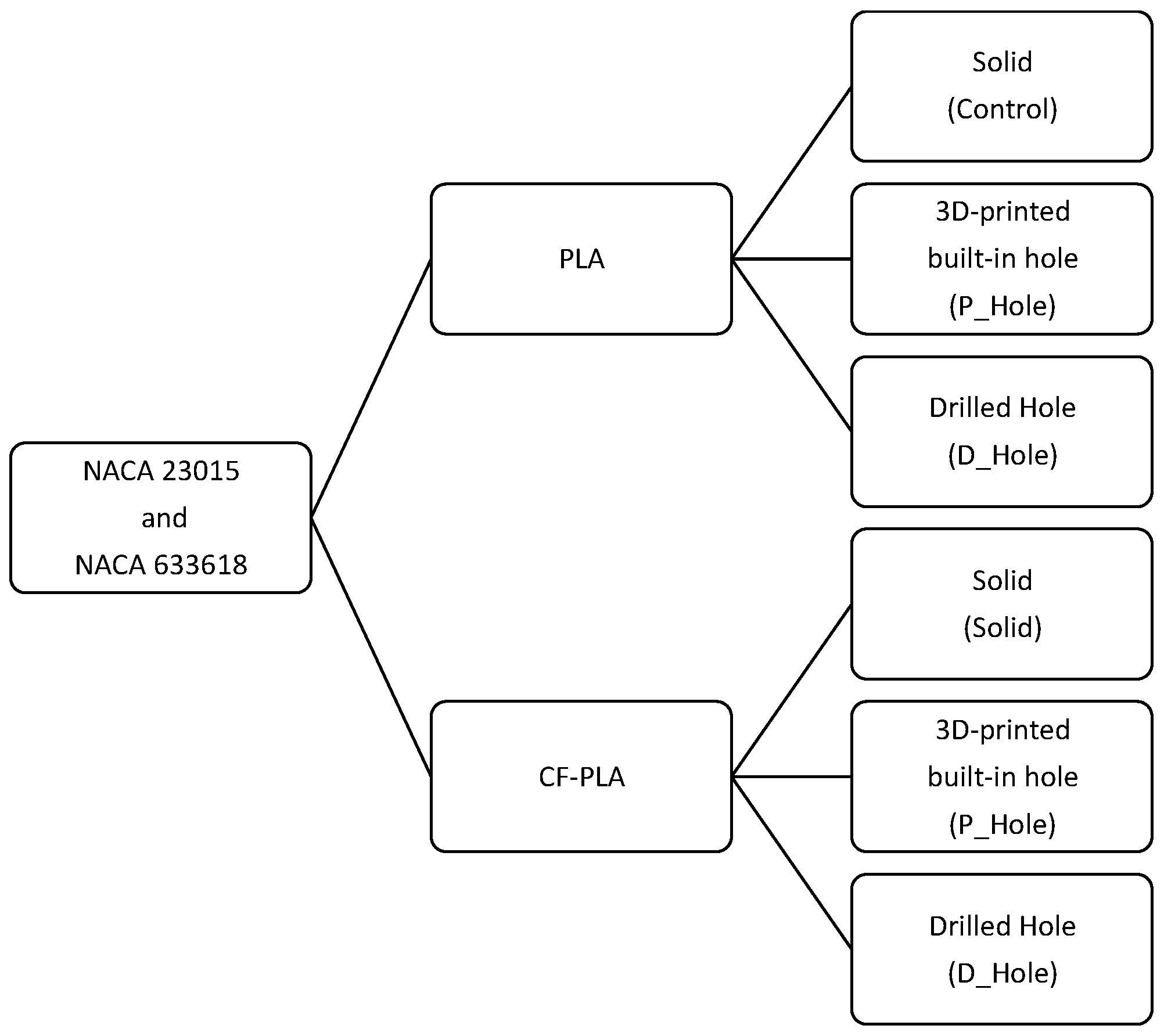
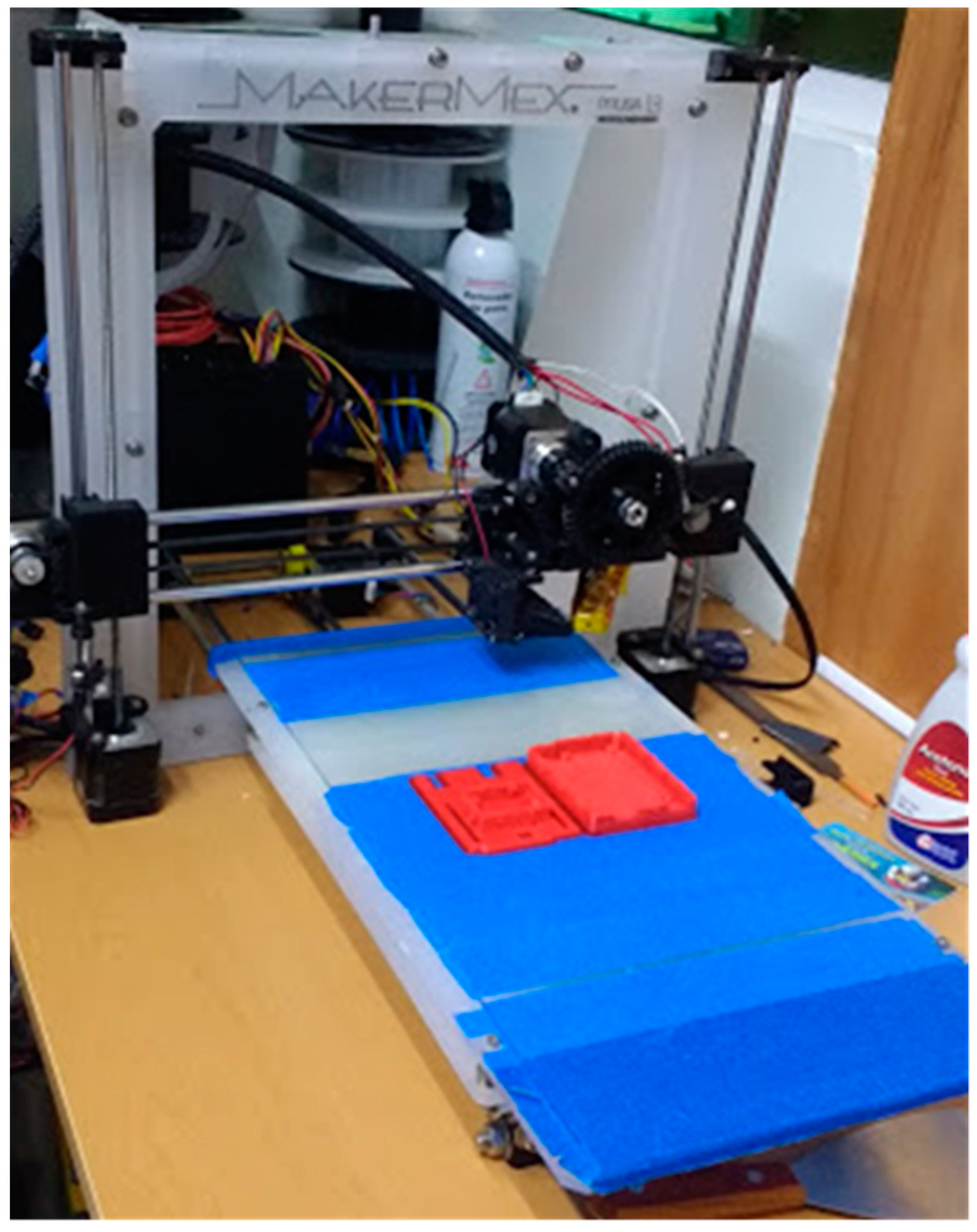
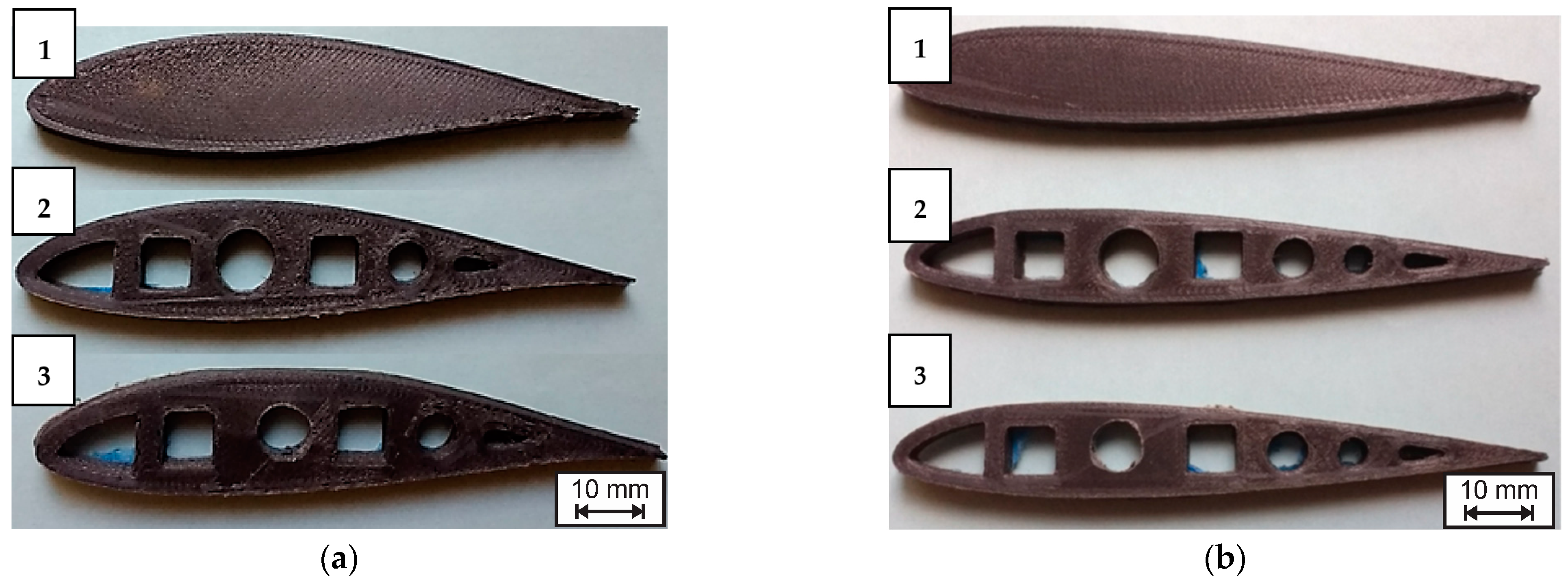
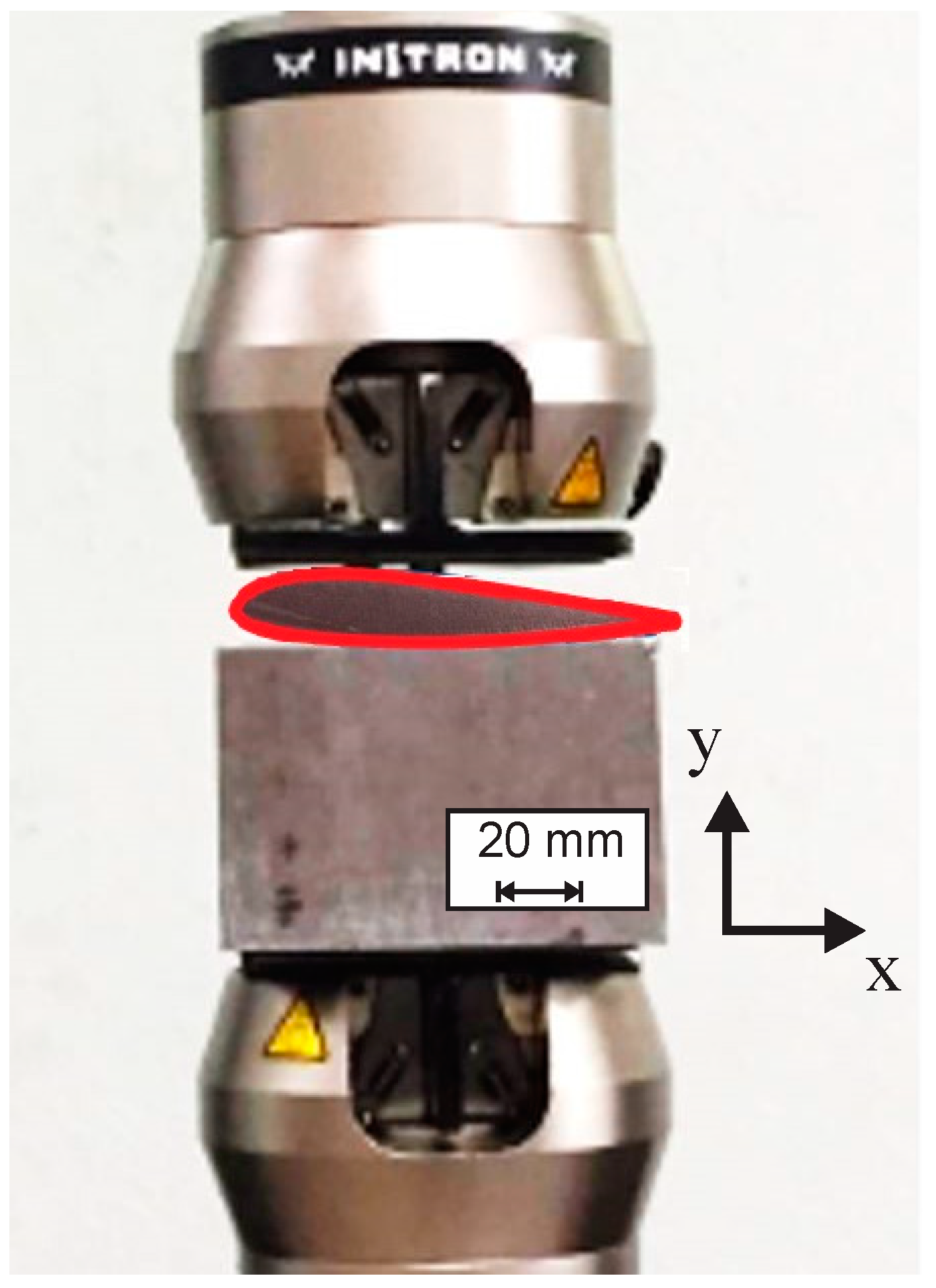
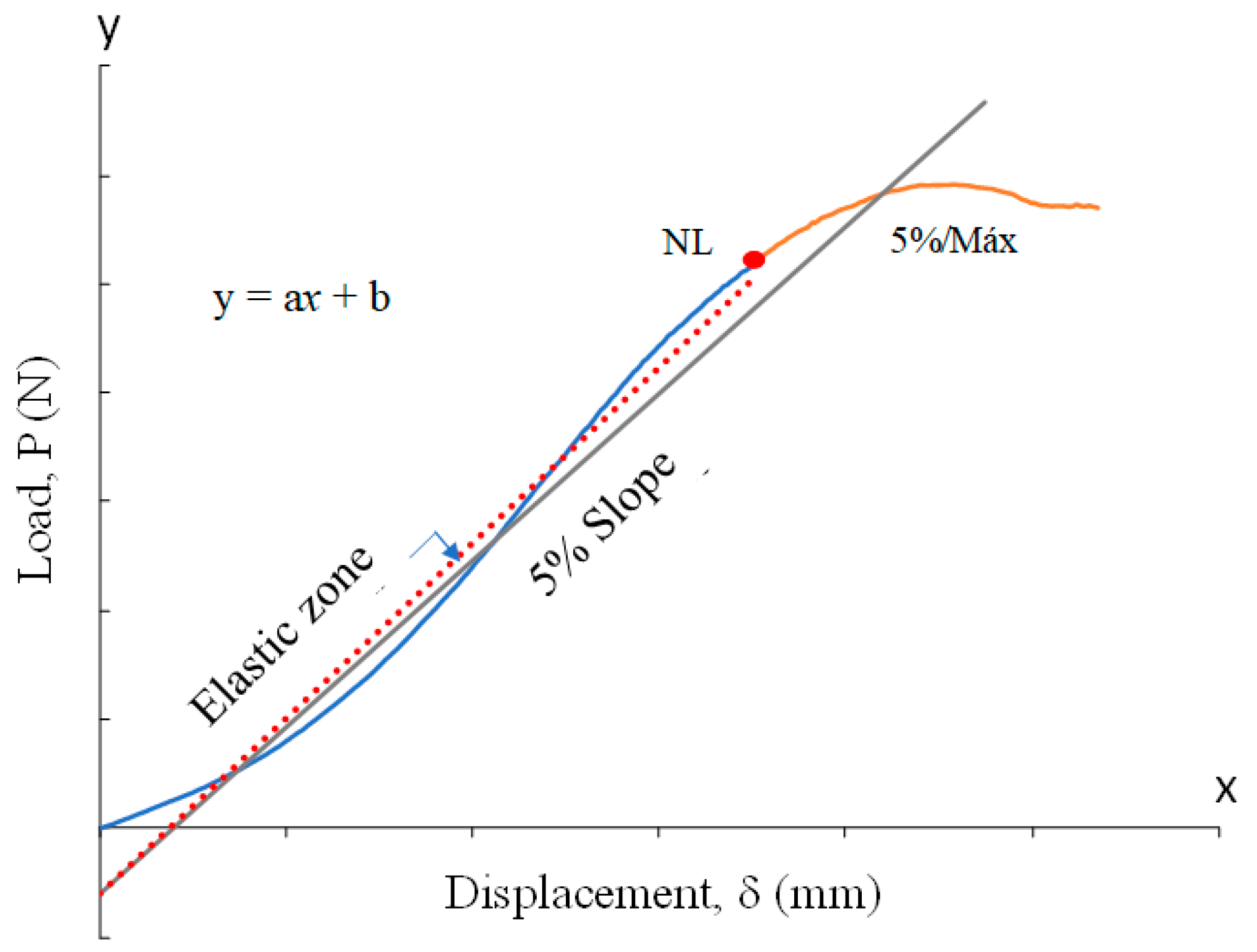

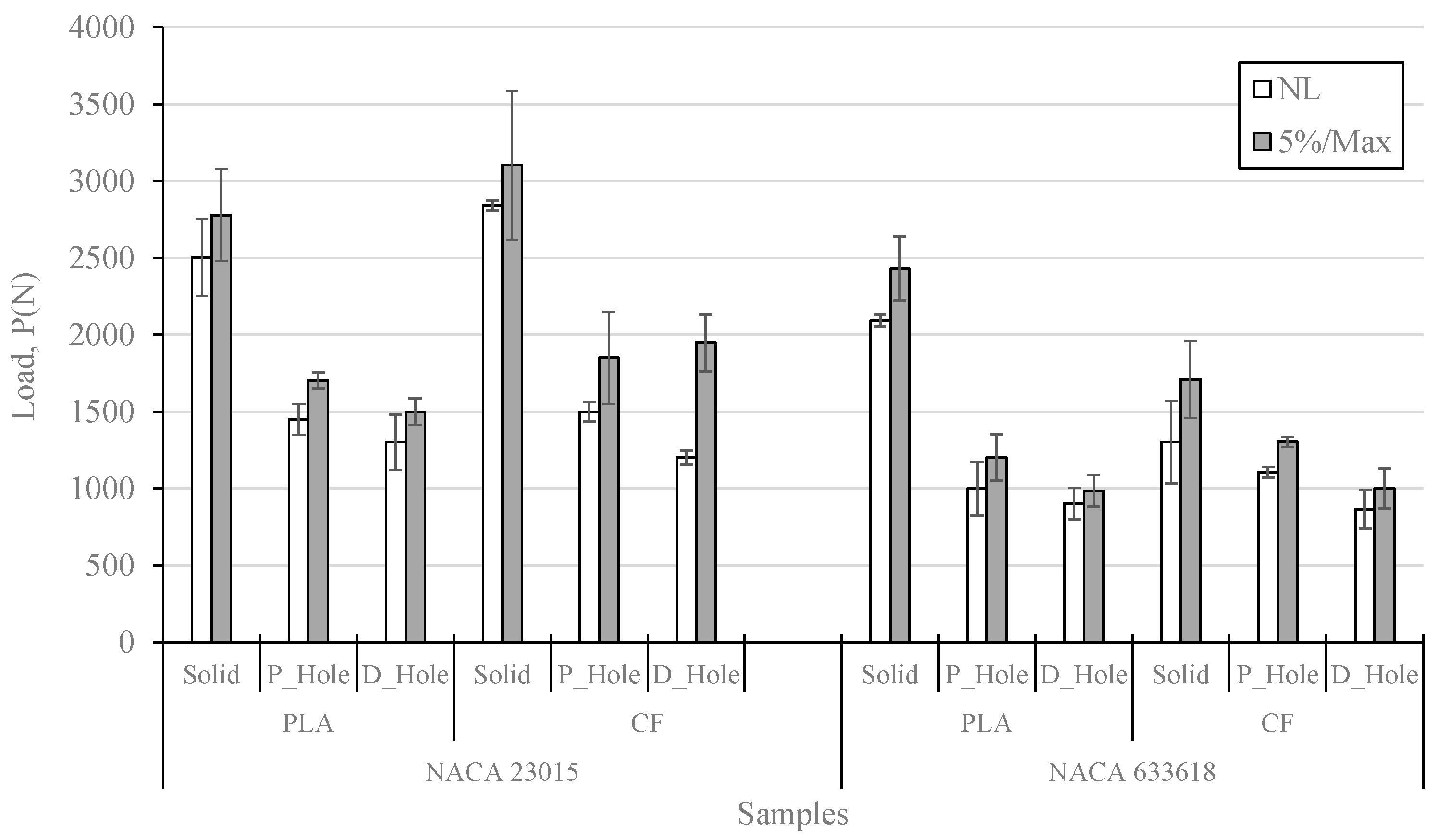


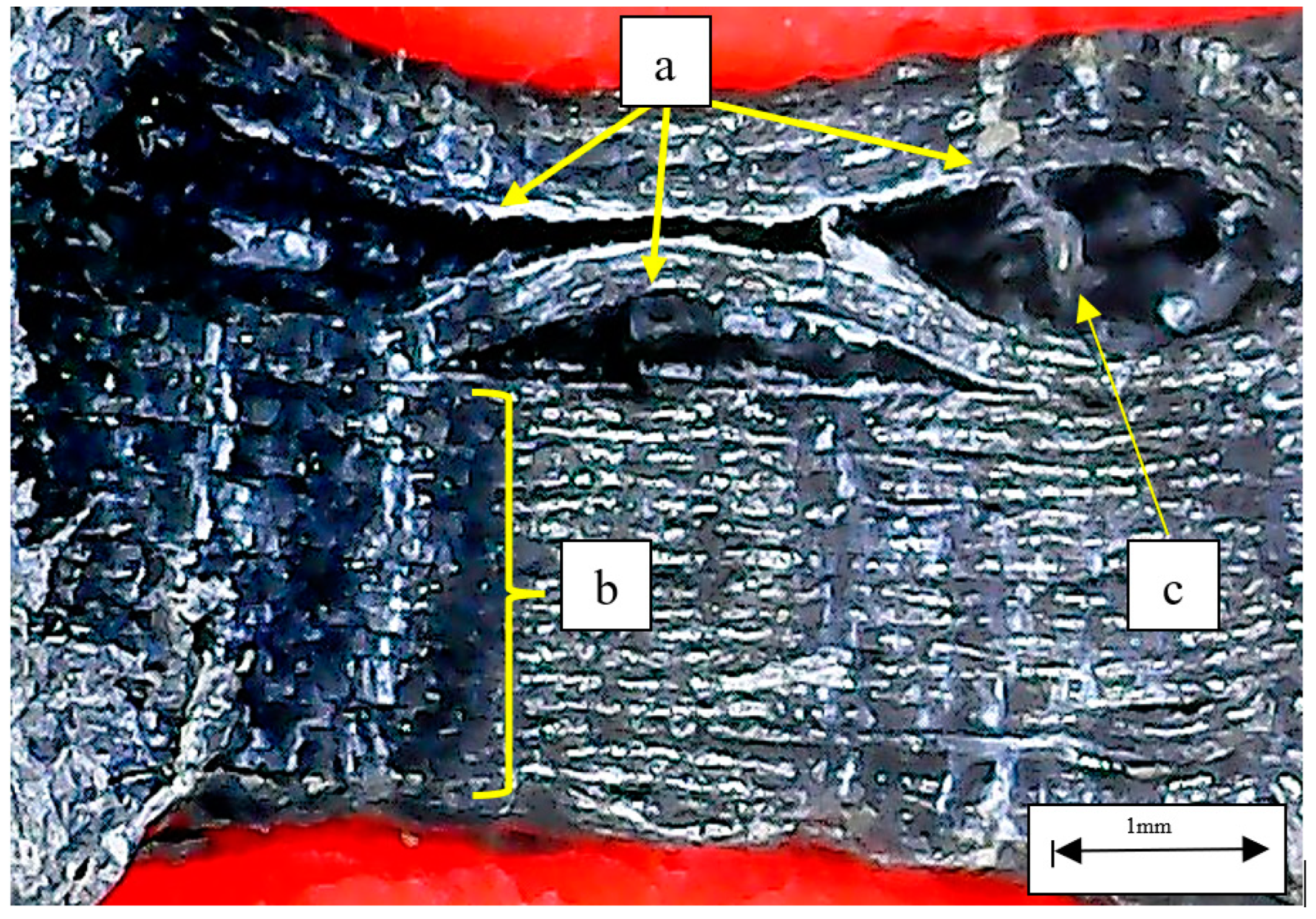
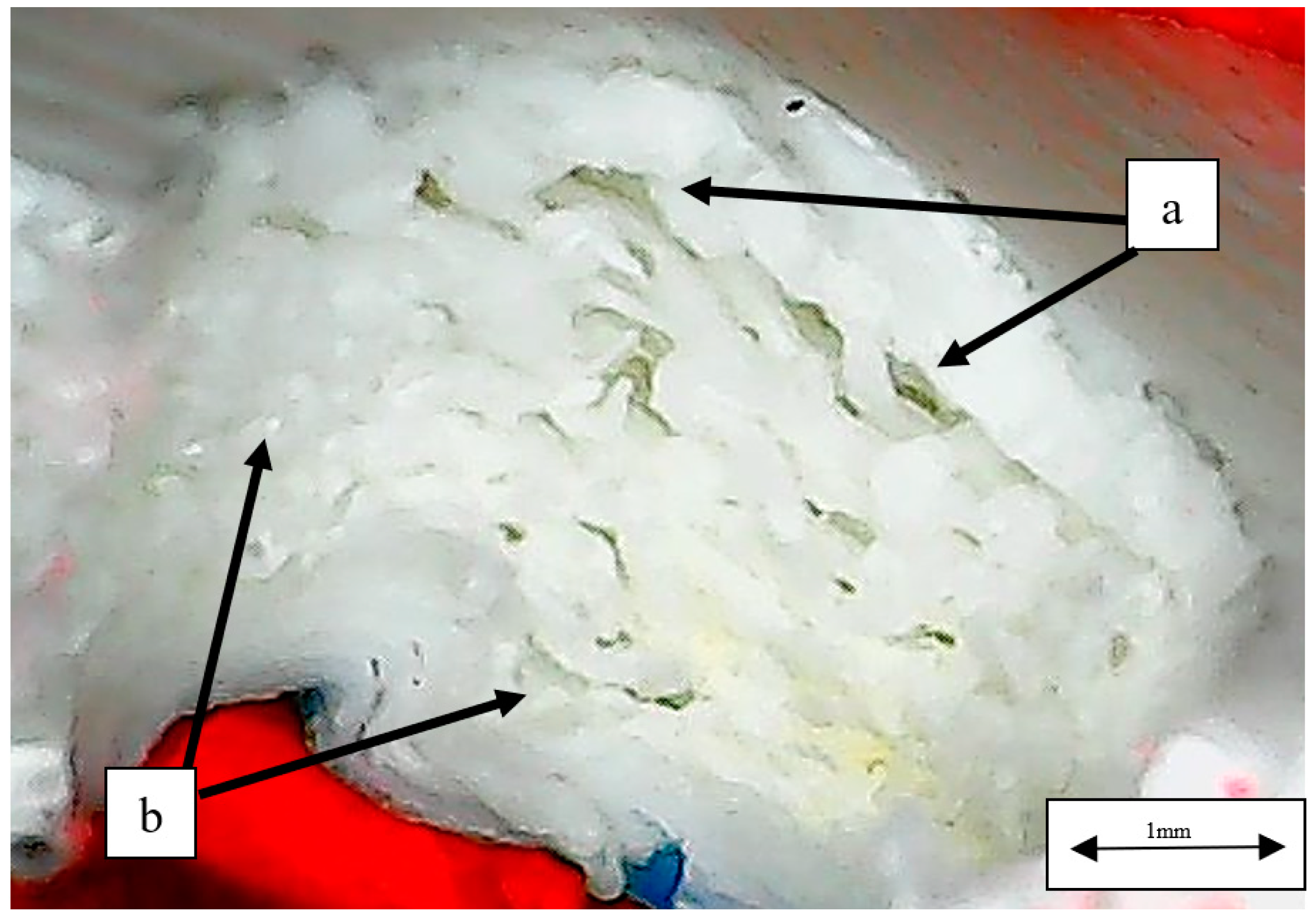
| Mechanical Properties | PLA | CF-PLA | Units |
|---|---|---|---|
| Young’s modulus | 3420 | 4791 | MPa |
| Poisson | 0.33 | 0.40 | -- |
| Tensile strength | 35.6 | 47.9 | MPa |
| Elongation at break | 4.2 | 2.0 | % |
| Flexural strength | 85.2 | 114 | MPa |
| Flexural modulus | 2378 | 6320 | MPa |
| Density | 1.24 | 1.29 | g cm−3 |
| Parameter | PLA | CF-PLA | Units |
|---|---|---|---|
| Printing density | 50 | 50 | % |
| Printing temperatures | 195 | 210 | °C |
| Initial printing temperature | 185 | 200 | °C |
| Final printing temperature | 180 | 195 | °C |
| Filament diameter | 2.85 | 2.85 | mm |
| Printing velocity | 50 | 50 | mm s−1 |
Publisher’s Note: MDPI stays neutral with regard to jurisdictional claims in published maps and institutional affiliations. |
© 2022 by the authors. Licensee MDPI, Basel, Switzerland. This article is an open access article distributed under the terms and conditions of the Creative Commons Attribution (CC BY) license (https://creativecommons.org/licenses/by/4.0/).
Share and Cite
Ramírez-Elías, V.A.; Damian-Escoto, N.; Choo, K.; Gómez-Martínez, M.A.; Balvantín-García, A.; Diosdado-De la Peña, J.A. Structural Analysis of Carbon Fiber 3D-Printed Ribs for Small Wind Turbine Blades. Polymers 2022, 14, 4925. https://doi.org/10.3390/polym14224925
Ramírez-Elías VA, Damian-Escoto N, Choo K, Gómez-Martínez MA, Balvantín-García A, Diosdado-De la Peña JA. Structural Analysis of Carbon Fiber 3D-Printed Ribs for Small Wind Turbine Blades. Polymers. 2022; 14(22):4925. https://doi.org/10.3390/polym14224925
Chicago/Turabian StyleRamírez-Elías, Víctor A., Noemi Damian-Escoto, Kyosung Choo, Miguel A. Gómez-Martínez, Antonio Balvantín-García, and José Angel Diosdado-De la Peña. 2022. "Structural Analysis of Carbon Fiber 3D-Printed Ribs for Small Wind Turbine Blades" Polymers 14, no. 22: 4925. https://doi.org/10.3390/polym14224925
APA StyleRamírez-Elías, V. A., Damian-Escoto, N., Choo, K., Gómez-Martínez, M. A., Balvantín-García, A., & Diosdado-De la Peña, J. A. (2022). Structural Analysis of Carbon Fiber 3D-Printed Ribs for Small Wind Turbine Blades. Polymers, 14(22), 4925. https://doi.org/10.3390/polym14224925








